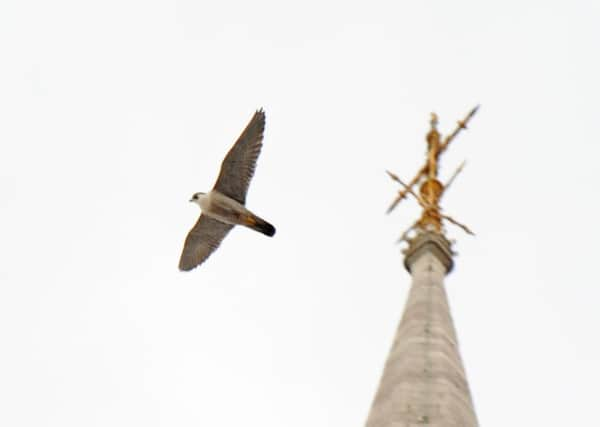Peregrine numbers at a historic high, new study finds


These slim bluish-grey falcons are formidable hunters, dropping like a thunderbolt on a pigeon or jackdaw before carrying it off to a favourite spot where they can finish it off at leisure.
It is a spectacular performance which can be witnessed in town and city centres across Yorkshire now including Sheffield, Wakefield, Leeds and York.
Advertisement
Hide AdAdvertisement
Hide AdNest boxes have been put up for them at a number of locations and there are live webcams trained on the Wakefield and Sheffield nests. A watchpoint organised by the RSPB to view the peregrines at Malham Cove in the Yorkshire Dales reopened this week.
This month the British Trust for Ornithology published the results of a peregrine survey carried out in 2014.
It showed that the estimated number of breeding peregrines in the United Kingdom now stands at 1,769 pairs, an historic high and a 22 per cent increase on the previous survey carried out in 2002.
The biggest increases have been in lowland England where of the 500 pairs monitored more than a quarter were nesting on buildings, pylons or other man-made structures. This was enabling the peregrines to move into new areas despite the lack of any cliffs to nest on. But peregrines are not doing well everywhere especially in upland areas where numbers in some places have fallen.
Advertisement
Hide AdAdvertisement
Hide AdThis is thought to be due to ongoing illegally killing and deliberate disturbance of nests and also changes in food supply caused by decreased availability of prey in some upland areas.
But overall there has been a complete reversal in the fortunes of the peregrine since the dark days in the 1960s where it was brought to the edge of extinction by chemical pesticides.
Kittiwakes were seen at several inland sites this week making their way back to east coast breeding sites. They spend the winter scattered around the North Atlantic and each spring a few follow rivers inland moving eastwards across country back to the North Sea.
A spoonbill is back on the Fairburn Ings reserve near Castleford, raising hopes of a second successful breeding season following last year when a pair successfully hatched three young – the first to breed in Yorkshire for more than 300 years.
Advertisement
Hide AdAdvertisement
Hide AdA Slavonian grebe was seen on the Nosterfield Quarry reserve in North Yorkshire and another two, along with a red-necked grebe at Barton-upon-Humber pits just across the Humber Bridge in North Lincolnshire.
Black redstarts were seen on passage at Flamborough, Filey and Kilnsea while ten Lapland buntings were in fields near Grange Farm, Bempton Lane.
One or two wheatears and ring ouzels were reported in the region midweek.